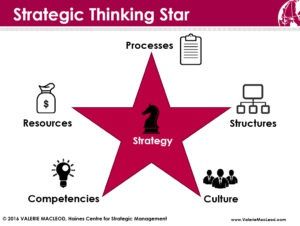Creativity as a competitive advantage
You are here: Home > Blog | Valerie MacLeod
05/04/2017
“In attempting to create a culture supportive of creativity and innovation, it has been found that one of the best approaches to describe organisational culture is based on the open systems approach” state E.C Martins & F. Terblanche in “Building organisational culture that stimulates creativity and innovation” in “European Journal of Innovation Management” (2003).
To develop creativity as a competitive advantage in your organization, you need to look at the entire organization and create cohesive plans and supports throughout all aspects of the organization.
Using The Haines Centre for Strategic Management’s “Strategic Thinking Star” I built upon the concepts from Martins’ and Terblanche’s article to show the links between strategy, processes, structures, culture, resources & competencies to create creativity as a competitive advantage.
As strategic thinkers we always start with strategy at the centre of the Strategic Thinking Star. All other parts of the Strategic Thinking Star support the strategy and each other.
Strategy:
Leadership must first agree that creativity is an important aspect of their strategy. In the Haines Centre’s processes, you must get feedback from key stakeholders around your strategy and include this into your plan and processes. This would include employees and middle management inside your org, as well as external key stakeholders like investors, customers, unions, etc.
Part of developing strategic plans includes scanning the external future environment to ensure that you are prepared for any possible future opportunities, trends & threats.
Staff at all levels need to understand the strategy and their part of implementing that strategy in their daily activities. We recommend that middle management have discussions with individual staff to ensure alignment of day-to-day duties and the overarching strategy.
Processes:
Processes are the way that staff do their jobs, make decisions, etc. All the processes and technology must support the strategy.
For example, the hiring process needs to hire creative and diverse staff; the reward & recognition process should recognize creativity and risk-taking, and not punish failures; leadership develop should include being creative and encouraging creativity in staff; communication processes need to continue sharing information about our creativity; the performance appraisals should include each person’s actions & training that support creativity; how we manage conflict must support creativity; and how we make decisions and handle change needs to be quicker and more flexible to allow for creativity.
Structures:
Structures organize people, ideas and things. The current structures (org charts, teams, buildings, reports, etc.) should be updated and created to support the new processes and the updated strategy. You may require a less hierarchical org structure to ensure that creative decisions can be made and implemented quickly.
You may need to reorganize your departments and teams so that they can be more creative, for example multi-discipline teams. You might create a new department that communicates about creativity, delivers creativity training and recommends reduction of impediments to creativity. Some organizations find that moving some design teams closer to the department that deals with customers increases creativity in product development.
Culture:
I call culture “the water you swim in.” Culture is the shared values, beliefs and behaviour expected of members of an organization. Culture is the unwritten rules about how things are done.
Culture is difficult to change, but it has been said many times that “culture eats strategy for breakfast.” If your culture doesn’t support the new strategy, your strategy has little chance of being implemented.
Define the culture and sub-cultures in your organization. Do they support creativity or the status quo? Does your culture build trust? If culture doesn’t support creativity, start working on changing your culture immediately. It will take time, but without a supportive culture you are in trouble.
Resources:
Resources are money, technology, people, time and space. You need to give the appropriate resources to your updated strategy, processes, structures, culture and competencies. This includes leadership support and decision making.
Competencies:
Change in your organization requires new competencies. Training, coaching & development in how to be creative and how to support creativity will be required at all levels.
Creativity does not happen on its own, you need a strategy for adopting creativity and the supporting processes, structures, culture, resources and competencies. You can make creativity a competitive advantage in your organization by using a systems view.
If you’d like to apply The Strategic Thinking Star to creativity or any other strategy, let’s talk: Valerie.MacLeod@HainesCentre.com


